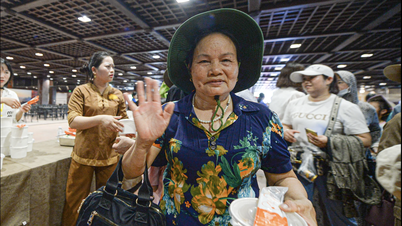The Politburo has just agreed with the Ministry of Health 's proposal on Party regulations related to handling violations of population policy, not to discipline cases of giving birth to a third child or more.

The Politburo agreed to the proposal not to discipline party members who have a third or more child - Illustration photo: DUYEN PHAN
Previously, according to regulation 102 of 2017 on disciplinary action against party members who violate the policy on population and family planning issued by the Central Executive Committee, the disciplinary action against party members who violate the policy on population and family planning is very "strict".
It specifically stipulates disciplinary levels from reprimand, warning to expulsion for party members who have a third, fourth, or fifth child.
By 2022, the Politburo issued Regulation 69 on disciplining party organizations and party members who violate the law. This new regulation no longer lists the disciplinary actions of party members who have a third, fourth, or fifth child, but instead uses the phrase "violation of population policy".
Party members who have a third or more child will violate population policy and may be subject to disciplinary action, except in a few specific cases.
Up to now, the Politburo has agreed to amend the regulations in the direction of not disciplining cases of giving birth to a third child or more, in line with amending legal regulations (not retroactively handling cases that have been disciplined).
According to the Ministry of Health, this is one of the policies to maintain the replacement fertility rate nationwide. Especially in the context of the fertility rate in our country has been continuously decreasing in recent years.
The Ministry of Health said the current replacement fertility rate is at its lowest level in 12 years and is expected to continue to decrease in the coming years.
The total fertility rate in 2022 will reach 2.01 children per woman; in 2023 it is estimated to be 1.96 children per woman. There is still a significant difference in fertility rates between regions and population groups, and this difference has not been clearly narrowed.
The trend of not wanting or having very few children has appeared in some urban areas where the economic conditions are developed. Meanwhile, in some places with difficult economic and social conditions, the birth rate is still high, even very high at over 2.5 children/mother of childbearing age. Meanwhile, in Ho Chi Minh City and the Southeast region, the Mekong Delta, the birth rate has decreased to 1.3-1.8 children/mother.
To maintain a stable replacement fertility rate (on average, each woman of childbearing age has 2.1 children) nationwide, the Ministry of Health proposes that couples and individuals have the right to voluntarily, equally and responsibly decide on having children, the time of giving birth, and the number of children.
The removal of disciplinary regulations for party members who have a third child is a policy that many party members are looking forward to so that they can decide for themselves the number of children they will have. The policy is also expected to contribute to increasing the birth rate in the current low birth rate situation.
Source: https://tuoitre.vn/tai-sao-can-bo-quy-dinh-ky-luat-truong-hop-sinh-con-thu-3-tro-len-20250219123122107.htm


![[Photo] Ready for the top competitions of Vietnamese table tennis](https://vphoto.vietnam.vn/thumb/1200x675/vietnam/resource/IMAGE/2025/5/18/9c547c497c5a4ade8f98c8e7d44f5a41)
![[Photo] Many young people patiently lined up under the hot sun to receive a special supplement from Nhan Dan Newspaper.](https://vphoto.vietnam.vn/thumb/1200x675/vietnam/resource/IMAGE/2025/5/18/6f19d322f9364f0ebb6fbfe9377842d3)



![[Photo] Party and State leaders attend the special art program "You are Ho Chi Minh"](https://vphoto.vietnam.vn/thumb/1200x675/vietnam/resource/IMAGE/2025/5/18/6895913f94fd4c51aa4564ab14c3f250)




























































































Comment (0)